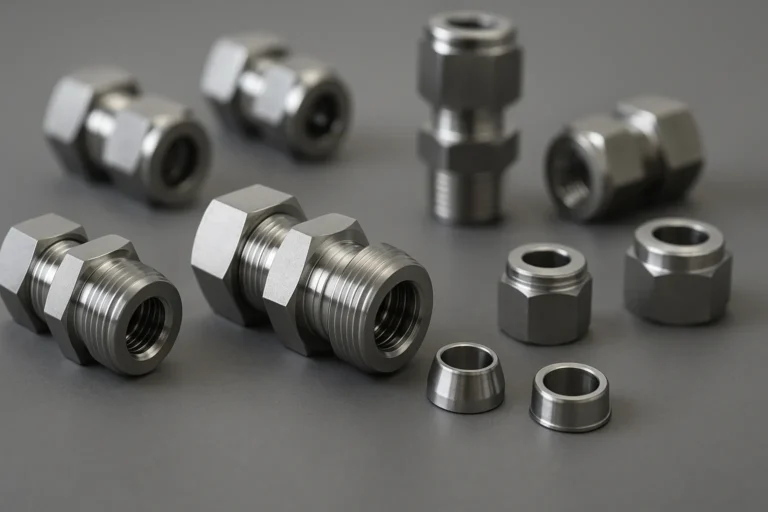Contact : +91-79045 61980 | Email: hydrofitengineers@gmail.com
Brass Compression Fittings- A Complete Guide to Reliable Pipe Connections
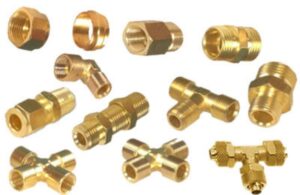
Brass compression fittings, an integral part of air and fluid systems, are now a cost-effective and leak-free alternative to solder connections. Their multipurpose design makes these the preferred choice for applications ranging from plumbing and heating to industrial systems.
At Hydrofit Engineers, your best hydraulic fittings in chennai, we offer a wide range of brass compression fittings that are designed to be robust and durable and are also resistant against corrosion with an easy installation process.
What Are Brass Compression Fittings?
These brass compression fittings are designed to be used with copper tubing. A typical assembly may include three primary elements:
- Compression Nut
- Ferrule (Compression Ring)
- Fitting Body
As the nut is tightened, the ferrule bites into the tubing and the soft metal of the nut is compressed down creating an air-tight seal with absolutely no leaks perfect for both liquid and gas applications.
Design Regulations for Brass Compression Fittings
Material Excellence: Brass is a corrosion-resistant metal that offers high machinability and pressure resistance, and provides good strength for durable lifting use in industrial environments. however many industry usage the strainless steel pipe fittings and quick connect fittings for their application.
- Three-Piece Construction: The nut, ferrule and body create a secure mechanical connection-no solder or adhesive needed.
- Universal Compatibility: Compatible with copper, stainless steel and plastic tubing for varying system designs.
- Ease of Assembly: Only simple hand tools are required – no special welding or soldering necessary!
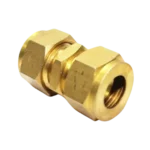
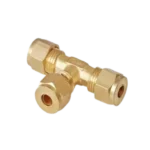
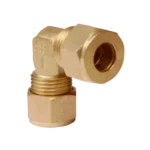
Functional Advantages of Brass Compression Fittings
- Leak-Proof: No leaks comes with pressure or vibration.
- Reusable: It can be recoil and reuse without damaging the performance.
- Resistant to Temperature & Pressure: Recommended for high pressure hydraulic and pneumatic systems.
- Cost Effective: Lower installation and lifetime costs.
- Durability: It isn’t prone to rust, corrosion or wear and tear, so it works best when fitted with both indoor and outdoor systems.
- Flexibility: Provides the user with minor 3-dimensional adjustability during installation.
Types of Brass Compression Fittings
| Type | Function |
|---|---|
| Straight Coupling | Joins two pipes in a straight line |
| Reducing Coupling | Connects pipes of different diameters |
| Union Coupling | Enables easy disconnection for maintenance |
| Elbow Fitting (45°/90°) | Redirects flow path |
| Tee Fitting | Creates a branch connection |
| Bulkhead Fitting | Enables sealed connections through panels or tanks |
| End Cap | Seals the end of a pipe |
| Adapters | Connects to other fitting types or threaded systems |
Applications of Brass Compression Fittings
Brass compression fittings are utilized across diverse domains such as:
- Water and gas supply systems
- Hydraulic equipment
- HVAC systems
- Air compressors and pneumatic tools
- Industrial automation
- Marine and offshore installations
Their versatility makes them an ideal option for residential and industrial piping. Read about versatility compression fittings here.
Sizes of Brass Compression Fitting
Brass compression fittings are made for imperial and metric tube sizes to cope with different system specifications:
- Diameter Range: 1/8” to 2”
- Tube OD (Outside Diameter): Most 1/4″, 3/8″, 1/2″ and 3/4″
- Termination Type: BSP, NPT and metric options
These are available in full conformance to the threads of Hydrofit Engineers hydraulic fitting products in Chennai as well.
Why Hydrofit Engineers For Brass Compression Fittings?
We, Hydrofit Engineers, are a renowned manufacturer, supplier and exporter of hydraulic & pneumatic fittings at Chennai. Our brass compression fittings are the perfect solution if you’re on ass rather tight budget, but still need quality and reliable structure. you can Explore our related product categories details here:
Conclusion
Brass Compression Fittings have a Smart, Fast and Durable Solution for both low and high pressure systems. Their versatility, corrosion resistance and reusability make them an ideal choice in hydraulic, pneumatic, instrumentation, refrigeration and other applications.
For premium-grade brass compression fittings in Chennai, choose Hydrofit Engineers or contact us for any query.

